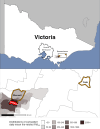Respiratory symptoms after coalmine fire and pandemic: A longitudinal analysis of the Hazelwood Health Study adult cohort
- PMID: 39841752
- PMCID: PMC11753711
- DOI: 10.1371/journal.pgph.0004186
Respiratory symptoms after coalmine fire and pandemic: A longitudinal analysis of the Hazelwood Health Study adult cohort
Abstract
The aim of this study was to determine whether the effects of extreme but discrete PM2.5 exposure from a coal mine fire on respiratory symptoms abated, persisted, or worsened over time, and whether they were exacerbated by COVID-19. We analysed longitudinal survey data from a cohort residing near a 2014 coalmine fire in regional Australia. A 2016/2017 survey included 4,056 participants, of whom 612 were followed-up in 2022. Items included respiratory symptoms, history of COVID-19, and time-location diaries from the mine fire period, which were combined with geospatial and temporal models of fire-related PM2.5. Longitudinal effects of fire-related PM2.5 were examined using a mixed-effects logistic regression model. Exacerbation due to COVID-19 was examined using a logistic regression model. PM2.5 exposure was associated with chronic cough and possibly current wheeze, chest tightness, and current nasal symptoms 2-3 years post-fire, and chronic cough and current wheeze 8.5-9 years post-fire. Further, the association between PM2.5 and chronic cough and possibly current wheeze appeared to increase between the survey periods. While there were no detectable interactions between PM2.5 and COVID-19, PM2.5 exposure was associated with additional respiratory symptoms among participants who reported a history of COVID-19. In summary, medium-duration exposure to extreme levels of fire-related PM2.5 may have increased the long-term risk of chronic cough and current wheeze. While the COVID-19 pandemic started several years after the mine fire, contracting this illness may have exacerbated the effect of fire-related PM2.5 through development of additional respiratory symptoms.
Copyright: © 2025 Lane et al. This is an open access article distributed under the terms of the Creative Commons Attribution License, which permits unrestricted use, distribution, and reproduction in any medium, provided the original author and source are credited.
Conflict of interest statement
I have read the journal’s policy and the authors of this manuscript have the following competing interests: MJA holds investigator-initiated grants from Pfizer, Boehringer-Ingelheim, Sanofi and GlaxoSmithKline for unrelated research. He has undertaken an unrelated consultancy for Sanofi and received a speaker's fee from GSK. The other authors declare no other competing interests. The remaining authors have declared that no competing interests exist.
Figures



Similar articles
-
Associations between Respiratory Health Outcomes and Coal Mine Fire PM2.5 Smoke Exposure: A Cross-Sectional Study.Int J Environ Res Public Health. 2019 Nov 2;16(21):4262. doi: 10.3390/ijerph16214262. Int J Environ Res Public Health. 2019. PMID: 31684042 Free PMC article.
-
Respiratory and atopic conditions in children two to four years after the 2014 Hazelwood coalmine fire.Med J Aust. 2020 Sep;213(6):269-275. doi: 10.5694/mja2.50719. Epub 2020 Aug 8. Med J Aust. 2020. PMID: 32770850
-
Does diet quality moderate the long-term effects of discrete but extreme PM2.5 exposure on respiratory symptoms? A study of the Hazelwood coalmine fire.Environ Res. 2024 Jul 1;252(Pt 3):119014. doi: 10.1016/j.envres.2024.119014. Epub 2024 Apr 27. Environ Res. 2024. PMID: 38685296
-
Long-term impact of exposure to coalmine fire emitted PM2.5 on emergency ambulance attendances.Chemosphere. 2022 Feb;288(Pt 1):132339. doi: 10.1016/j.chemosphere.2021.132339. Epub 2021 Sep 23. Chemosphere. 2022. PMID: 34628124
-
Long-term impacts of coal mine fire-emitted PM2.5 on hospitalisation: a longitudinal analysis of the Hazelwood Health Study.Int J Epidemiol. 2022 Feb 18;51(1):179-190. doi: 10.1093/ije/dyab249. Int J Epidemiol. 2022. PMID: 34871381
References
-
- Luhar AK, Emmerson KM, Reisen F, Williamson GJ, Cope ME. Modelling smoke distribution in the vicinity of a large and prolonged fire from an open-cut coal mine. Atmos Environ. 2020;229:117471. doi: 10.1016/j.atmosenv.2020.117471 - DOI
-
- Environment Protection Authority Victoria. PM2.5 particles in the air. In: EPA Victoria [Internet]. Environment Protection Authority Victoria; 2021. Aug 9 [cited 2023 Jul 18]. Available from: https://www.epa.vic.gov.au/for-community/environmental-information/air-q...
LinkOut - more resources
Full Text Sources
